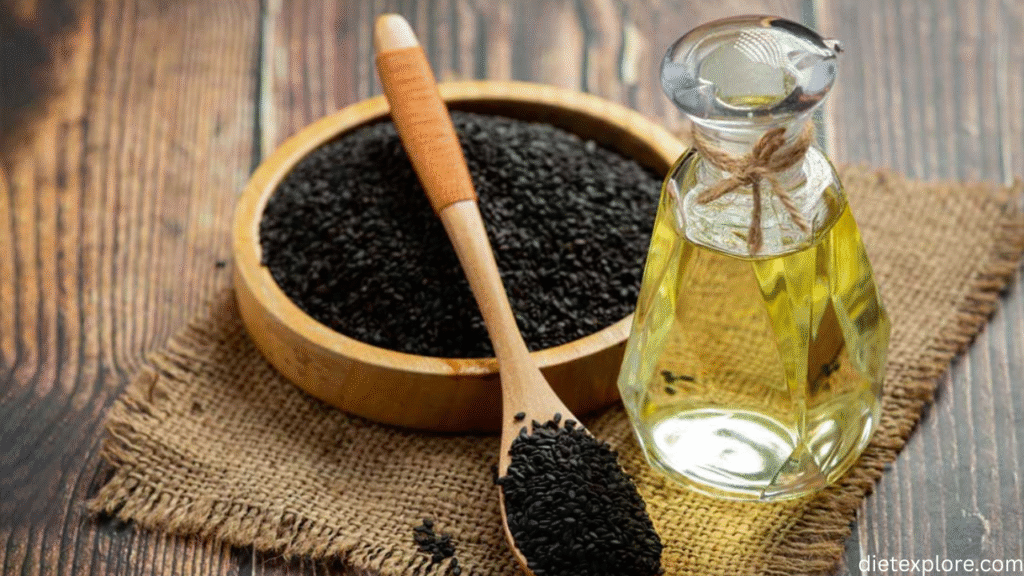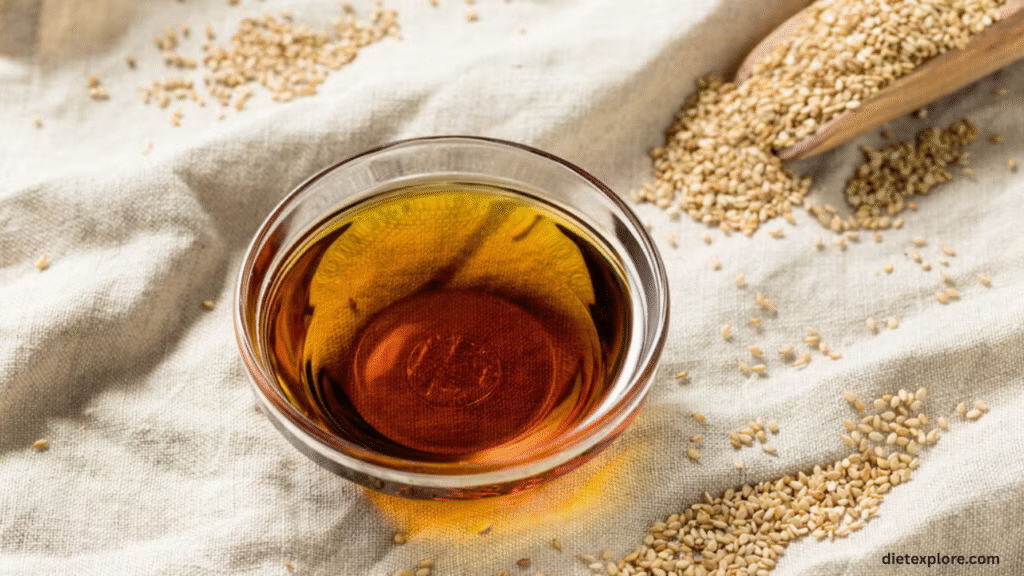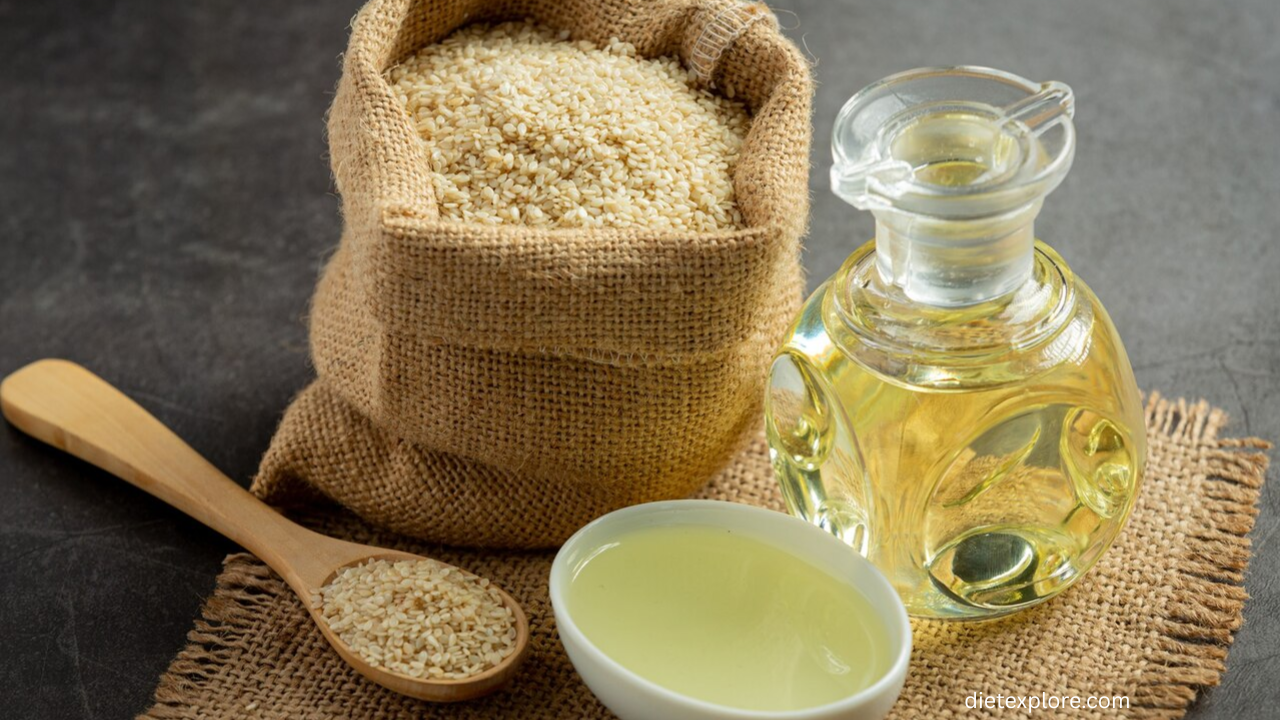Sesame Oil
Sesame oil is a versatile edible oil derived from sesame seeds (Sesamum indicum), recognized as one of the earliest-known crop-based oils in human history. Cultivated for over 5,000 years in regions like the Indus Valley, Mesopotamia, and ancient Egypt, it has long been valued for its nutritional, medicinal, and culinary properties.
From a nutritional standpoint, this oil is rich in healthy fatty acids — about 40 % oleic acid (monounsaturated) and 42–44 % linoleic acid (polyunsaturated), with around 9 % saturated fat. It also contains bioactive compounds like lignans (sesamin, sesamolin), sesamol, and γ-tocopherol (a form of vitamin E), all of which contribute potent antioxidant and health-promoting properties.
It is prized not just for its nutritional profile, but also for its distinct flavor and stability, making it a staple in Asian, Middle Eastern, and Mediterranean cuisines. Its unique combination of ancient lineage, flavorful profile, and health benefits positions it as a timeless kitchen essential.
Toasted Sesame Oil
Toasted sesame oil is crafted by roasting sesame seeds before pressing, producing a rich, dark amber oil with an intensely nutty, aromatic flavor. Unlike the light-colored raw version, it’s used in small amounts as a finishing oil rather than for frying or high-heat cooking.
The roasting process amplifies both flavor and antioxidant content: it increases levels of lignans (sesamin, sesamolin), sesamol, and other compounds, enhancing both sensory appeal and oxidative stability. However, excessive heat during roasting can produce undesirable compounds such as acrylamides or furans, detracting from quality.
In the kitchen, toasted sesame oil adds a rich, toasted depth to dishes—ideal for dressings, marinades, soups, or as a final flavor boost. Its low smoke point (around 350 °F) means it can become burnt or bitter if overheated. Used judiciously, its flavor-forward profile enhances culinary creations beautifully.
Also Read: /liquid-collagen/
Substitute for Sesame Oil
Different Substitutes
When sesame oil isn’t available or suitable, neutral-flavor oils with similar cooking properties serve as good substitutes. Common alternatives include:
- Canola oil or grapeseed oil: both have light taste, high smoke points, and are suitable for general cooking or frying.
- Sunflower oil or vegetable oil mix: readily available and neutral in flavor, though they may lack sesame oil’s antioxidant profile.
In Asian or Middle Eastern-inspired recipes, neutral oils work well, especially when balanced with flavor from spices or condiments. For an aromatic toasted sesame oil effect, consider adding a small drizzle of another nut/seed oil like toasted walnut or peanut oil at the end—but note allergy concerns must be considered.
In summary, for high-heat or everyday cooking, light, stable oils like canola or grapeseed are functional substitutes. For flavor enhancement, finishing oils with nutty profiles, used sparingly, are the closest alternatives.

Sesame Oil Substitute
Here’s a clearer breakdown of what can replace sesame oil, distinguishing between functions:
- Cooking (High Heat) Substitute
- Use light-colored sesame oil, or preferably neutral oils like canola, grapeseed, sunflower, or vegetable oil blends.
- These oils withstand heat, have higher smoke points, and won’t impart strong flavor.
- Flavor (Finishing) Substitute
- When aiming for the nutty aroma, use toasted sesame oil sparingly, if available.
- If unavailable, toasted peanut oil, walnut oil, or even whole toasted sesame seeds can mimic the flavor profile—again, use sparingly and consider allergy risks.
Note: The purposes differ—cooking substitutes need heat stability; flavor substitutes need aromatic strength. Choose based on whether you prioritize function or flavor.
Is Sesame Oil a Seed Oil?
Yes — sesame oil is definitively a seed oil. By definition, seed oils are extracted from the seeds of plants, and it also falls squarely within this category.
Despite being a seed oil, it is often seen as nutritionally superior to many other seed oils due to its antioxidant-rich composition. It’s rich in lignans (sesamin, sesamolin), sesamol, and γ-tocopherol, all of which slow oxidation and extend shelf life. Indeed, manufacturers sometimes add these sesame-derived antioxidants to other oils to improve their stability.
Nevertheless, as a seed oil high in polyunsaturated (omega-6) fatty acids, it must be used wisely—especially at high heat, where oxidation may still occur.
In short: sesame oil is a seed oil, but enriched with natural antioxidants that make it more stable and health-promoting compared to many others in its class.
Does Sesame Oil Go Bad?
Good or Bad
Sesame oil can go rancid, although it is more resistant to spoilage than many other oils thanks to its powerful antioxidants — sesamol, sesamin, and γ-tocopherol.
Typical shelf life:
- Many sources suggest a best-by date of around 2 years from manufacturing.
- Culinary experts often recommend using it within 1 year of purchase, regardless of whether it’s opened or not.
Storage matters:
- Store in cool, dark, and dry places; refrigeration extends freshness (though may cause temporary cloudiness).
- Exposure to light, heat, and oxygen accelerates rancidity.
Health risk:
- Rancid oil is unpleasant in flavor, but unlikely to cause immediate harm.
In short: It is relatively stable, but to preserve its flavor and quality, store it properly and use it within a reasonable time—ideally 1–2 years from production.

Sesame Oil Replacement
When replacement is necessary, here’s what to consider:
| Purpose | Best Replacement Options | Notes |
|---|---|---|
| High Heat Cooking | Refined sesame oil (light), canola, grapeseed, sunflower oils | High smoke point, flavor-neutral |
| Flavor Enhancement | Toasted sesame oil, toasted peanut or walnut oil, toasted sesame seeds | Use sparingly; peanuts/walnuts pose allergy risks |
| Health/Nutrient Structure | Oils high in monounsaturated fat (like olive or avocado) | Different flavor but nutritive benefits |
| Avoiding Allergens | Nut-free oils: avocado, sunflower, or olive oils | For those with sesame allergy |
In sum: choose your substitute based on function—whether you need the oil for high-heat stability, aromatic impact, or nutritional similarity.
Sesame Oil for Hair
Sesame oil is increasingly valued in hair care and beauty regimes, owing to its nourishing and protective properties:
- Rich in fatty acids (oleic, linoleic) and antioxidants like sesamin, sesamolin, sesamol, and vitamin E, it helps moisturize, strengthen hair strands, and combat oxidative damage.
- Traditionally, it’s used in Ayurvedic and traditional medicine for scalp massage, promoting hair health, shine, and potential growth.
Here’s a comparison table highlighting benefits:
| Benefit | Description |
|---|---|
| Moisturizing & Conditioning | Deeply penetrates hair shaft; helps reduce frizz and dryness |
| Antioxidant Protection | Lignans (sesamin, sesamolin) and vitamin E help shield hair from oxidative stress |
| Scalp Health | May soothe dryness, reduce inflammation, and improve scalp circulation |
| Strength & Shine | Fatty acids and nutrients contribute to stronger, shinier hair |
How to use: apply warm oil to scalp and hair; massage gently; leave for 30 minutes or overnight, then wash with shampoo. Regular use may enhance hair texture, elasticity, and scalp health.
Conclusion
Sesame oil stands out as a culinary and holistic powerhouse. Derived from one of humanity’s oldest oilseed crops, it delivers a compelling blend of nutritional value, antioxidant-rich stability, and distinctive culinary flair. Whether you choose the neutral light version for cooking or the intense toasted variety for finishing, this oil offers both flavor and function in abundance.
It embeds itself deeper into the wellness narrative thanks to its lignans, tocopherols, and phenolic compounds. It offers heart-friendly, anti-inflammatory, and protective benefits for body and hair. Yet, mindful handling—choosing the right type, storing it correctly, and noting smoke points—is key.
Even when substituting, understanding whether the priority is heat resilience, nutritional match, or aromatic profile will guide you to the appropriate alternative. And for those exploring hair care, sesame oil’s enriching blend makes it a worthy natural treatment.
Overall, this oil’s merits its enduring role—from ancient medicine cabinets to modern kitchens and beauty routines. With smart use, it continues to deliver health, flavor, and tradition in each golden drop.




